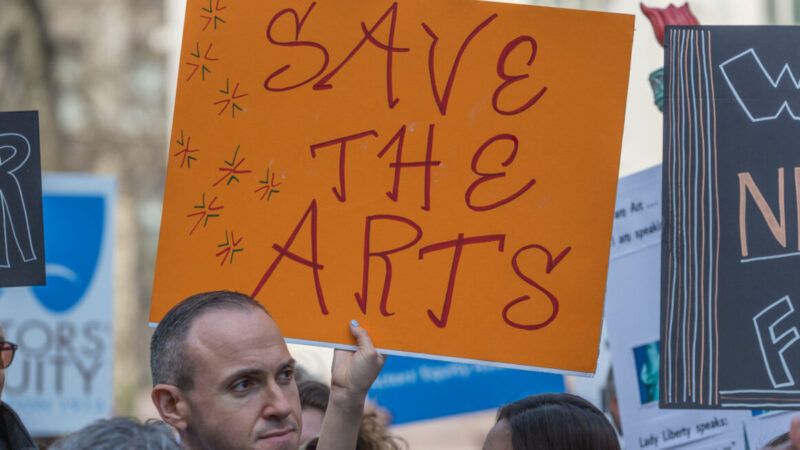Propaganda Art Gets Boost in Biden Budget
What else is government-funded art but propaganda for the rulers?

The astonishing $6 trillion budget proposed by President Joe Biden includes a 20 percent increase in funding for the National Endowment for the Arts (NEA). While that $201 million sounds like real money, it's admittedly a pretty small slice, just 0.003 percent of the whole. And it is surely one of the most innocent of federal expenditures: supporting mega-museums and community orchestras is about the least dangerous piece of government spending I can think of. (It beats a new weapons system or internment facility.)
Proponents of more funding for the arts often point out that many "developed" countries, such as the United Kingdom and Germany, spend much more government money supporting the arts than the U.S. does. But leaving aside the question of whether the U.S. should emulate Germany's history of state support for the arts, one might worry that arts expenditures do not seem practically to do much in the way of securing the common defense or ensuring the blessings of liberty to ourselves and our posterity. There's no sign that the founders of the Republic regarded support of the arts as the business of the federal government whatsoever.
And yet, it is often said, the arts are central to any culture, to the unity and character of any people. The NEA is constantly hinting with an anodyne wave that it is telling the story of who we are as Americans: "The arts are a powerful and important part of what unites us as Americans. The arts celebrate our differences while connecting us through a communal experience….[NEA grants seek to] enrich our humanity by broadening our understanding of ourselves as individuals and as a society." Well, it's hard to argue with that, I suppose, and who would endorse disenriching humanity? Giving some federal support, I have heard it said, expresses that we, as Americans, are concerned not just with guns and butter but with meaning.
But if arts funding is to show "who we are as Americans," or to narrate our alleged communal experience, it is going to have to respond to the tastes of the American people, which at the moment run to autotuned hip hop and bro country. Perhaps the tastes of we, the American people, should be somewhat reshaped through arts education, or through the intervention of the New York Philharmonic. But you may, after a bit of reflection, agree with me that the government is an implausible agent of our refinement, maybe not who we ought to appoint as our critic-in-chief. The bureaucracy as tastemaker: Well, it just does not appear plausible, and it has an unwholesome history.
In 1989, Sen. Jesse Helms (R–N.C.) and others of what was then known as "the moral majority" held up NEA funding over a series of grants to avant-garde artists such as Robert Mapplethorpe and Karen Finley. They were offended by the sexual or supposedly blasphemous content of works like Andres Serrano's "Piss Christ," a photograph of a crucifix submerged in the artists' urine.
The whole controversy almost ended the NEA, and emblematized the culture wars of that moment, pitting southern evangelical Christians against New York curators. Ever since, the NEA's grantmaking has been much safer; it's basically turned from funding individual artists to funding community arts organizations. It has largely avoided controversy over the last 20 years.
But if the arts are part of the federal budget, they are subject in a democracy to political processes, and ought to be. And as federal spending increases (and increases), keep in mind that it is liable to be supervised, after the next election or the one after that, by people whose tastes you deplore. Less than two years ago, the Trump administration promulgated the executive order "Promoting Beautiful Federal Architecture," condemning modernism and instructing that all new federal buildings be designed in a classical style. A later administration might drive a revival of brutalism.
Government-funded art, that is, descends into propaganda almost no matter what its content: It expresses all sorts of things about what the ruling party wants you to be and what it wants you to see. It expresses, at best, an elaborate set of political negotiations about what sorts of creative expression are appropriate. That is very unlikely to contribute to the intensity or sincerity, the diversity and the funk, that we should associate with creativity.
Every form of arts funding (foundation grants, private sales, crowdsourcing) brings with it certain pressures and distortions, and I know artists and organizations who have done good work with NEA grants. But government funding, in which state coercive power (taxation, to begin with) underlies the grant-making, makes for art that directly serves political power and raises particularly excruciating problems with regard to the possibilities of creative expression, seen in authoritarian regimes but also in democracies. The will of the voters is only a marginally more reliable aesthetic guide than the will of the ruler, but the will of the voters should guide federal expenditures.
Almost any other way of funding the arts is preferable.
Show Comments (49)